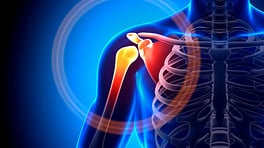
Rotator Cuff Tears:
What is this condition? What causes this condition?
The rotator cuff is made up of 4 distinct muscles known as supraspinatus, infraspinatus, teres minor and subscapularis. These muscles stem from the scapula, connecting to the humeral head to form a cuff around the glenohumeral joint; to provide strength and stability to the shoulder complex (Hsu et al., 1997). Injury and degeneration are two main causes of rotator cuff tears and commonly present in the dominant arm (Weber & Chahal, 2020). Acute tears are usually due to injury either in isolation or along with other shoulder injuries (e.g., dislocated shoulder, falling onto an outstretched hand or unexpected force during pushing or pulling), (Weber & Chahal, 2020). More commonly, tears are caused by degeneration that naturally occurs with age-related muscle deterioration (Weber & Chahal, 2020).
Common symptoms / signs
Common signs and symptoms experienced when a rotator cuff tear is present include (May & Garmel, 2019), (Edwards et al., 2016) & (Lädermann, Denard, Collin, 2015):
- Severe pain at time of injury
- Increasing pain/difficulty with overhead activities, lifting and carrying heavy objects
- Pain at night when sleeping on injured side
- Positive painful arc sign (during 70-120 degrees of abduction)
- Weakness and reproduction of pain during resisted abduction or external rotation
- Muscle atrophy of supraspinatus and infraspinatus
- Radiating pain to deltoid muscle
- Shoulder stiffness
- Supraspinatus tears may present with pain located on anterior aspect of shoulder with symptoms radiating down the arm as well as tenderness over the greater tuberosity
Risk factors of this condition?
Rotator cuff tear risk factors mentioned by Weber and Chahal (2020) & May and Garmel (2019) include:
- Aged greater than 40 years
- Smoking
- Family history
- Poor posture
- Trauma or repetitive micro trauma (noticed in baseball pitchers and tennis players)
- Hypercholesterolemia
- Occupation/activities requiring significant overhead activities (painters and carpenters)
How is it treated?
May & Garmel (2019) recommend surgical treatment for complete tears in patients under 40 years with follow-up rehabilitation. However, newly diagnosed patients with symptomatic rotator cuff tears are advised to attend physiotherapy to address core and scapular strengthening (May & Garmel, 2019). Physiotherapy resulted in superior effective outcomes in both small-medium sized tears and full thickness tears over 2 years (May & Garmel, 2019). May & Garmel (2019) also discuss potential corticosteroid injection for patients, although there is limited evidence supporting the effectiveness of this treatment modality in the long term.
Edwards et al. (2016) supports conservative management of rotator cuff tears to reduce pain and improve function. They discovered that a 12-week exercise program, regardless of being gym or home based, offered greater outcomes when compared to surgical interventions (Edwards et al., 2016). Physiotherapy goals included restoration of full and pain-free range of motion and strength, muscle balance and flexibility and glenohumeral and scapulothoracic muscular stability and control. Through the exercises listed below, Edwards et al (2016) was able to achieve these goals.
- Pendulum exercise
- Active-assisted external rotation and elevation (using a bar/stick and non-affected arm to generate the movement)
- Cross-body stretch for the posterior capsule
- Anterior capsule/pectoralis minor stretch (using a doorframe/wall)
- Low row exercise
- Side-lying shoulder external rotation
- Prone shoulder extension
- Supine shoulder flexion, incline shoulder flexion and standing shoulder flexion
Along with a rotator cuff exercise program, patient education is vital. Education should be focused on improving modifiable physical impairments that contribute to pain and dysfunction. This involves teaching the patient appropriate neuromuscular control of the shoulder girdle and thoracic posture to assist in improving scapular stability (Edwards et al., 2016).
Other causes?
Extrinsic and intrinsic factors can contribute to the etiology of rotator cuff tears. Hsu et al. (1997) discuss extrinsic factors including tensile overload and repetitive stress as well as subacromial or internal impingement. They continue to explore intrinsic factors which involve matrix composition and poor vascularity (Hsu et al., 1997). Smoking and joint capsule inflammation/frozen shoulder are also common contributing factors that increase the risk of developing a rotator cuff tear (Hsu et al., 1997).
References:
Edwards, P., Ebert, J., Joss, B., Bhabra, G., Ackland, T., & Wang, A. (2016). Exercise rehabilitation in the non-operative management of rotator cuff tears: a review of the literature. International journal of sports physical therapy, 11(2), 279.
Hsu, H. C., Luo, Z. P., Cofield, R. H., & An, K. N. (1997). Influence of rotator cuff tearing on glenohumeral stability. Journal of shoulder and elbow surgery, 6(5), 413-422.
Lädermann, A., Denard, P. J., & Collin, P. (2015). Massive rotator cuff tears: definition and treatment. International orthopaedics, 39(12), 2403-2414.
May, T., & Garmel, G. M. (2019). Rotator cuff injury.
Weber, S., & Chahal, J. (2020). Management of rotator cuff injuries. JAAOS-Journal of the American Academy of Orthopaedic Surgeons, 28(5), e193-e201.
